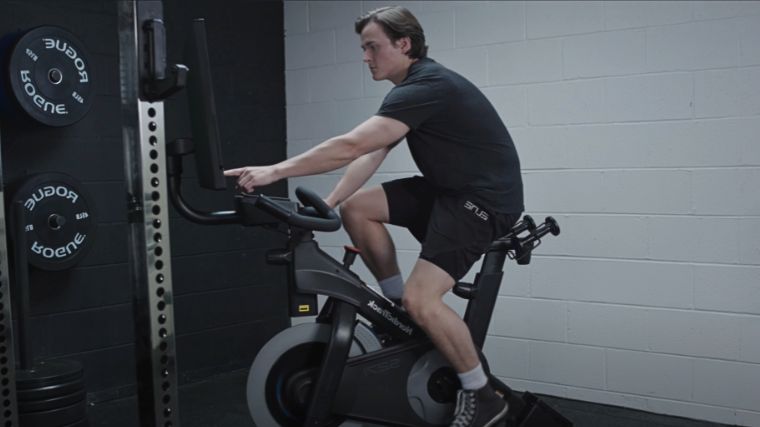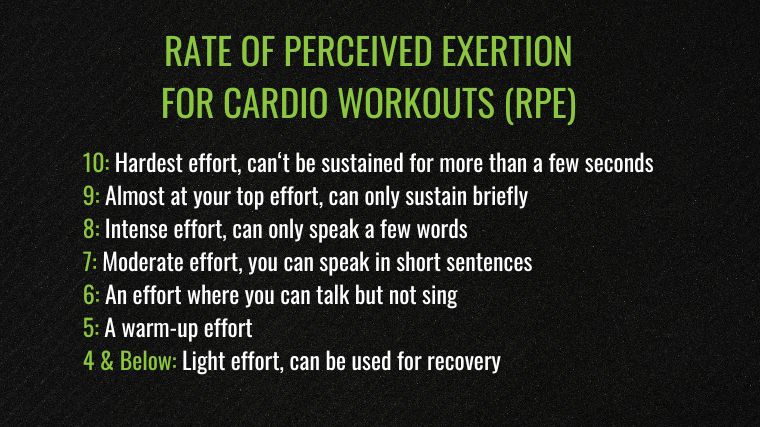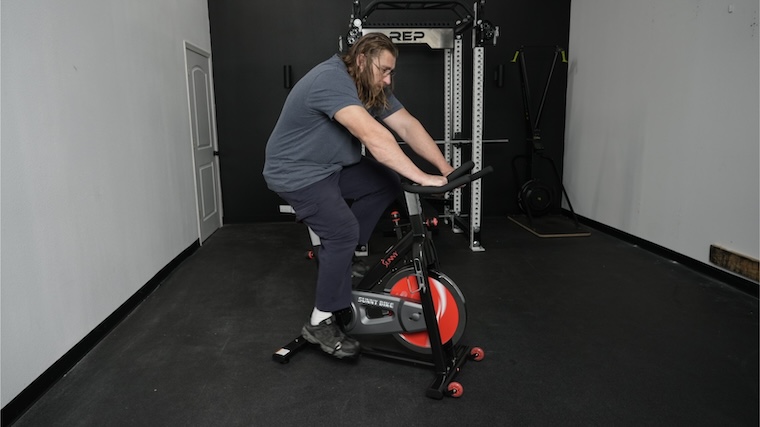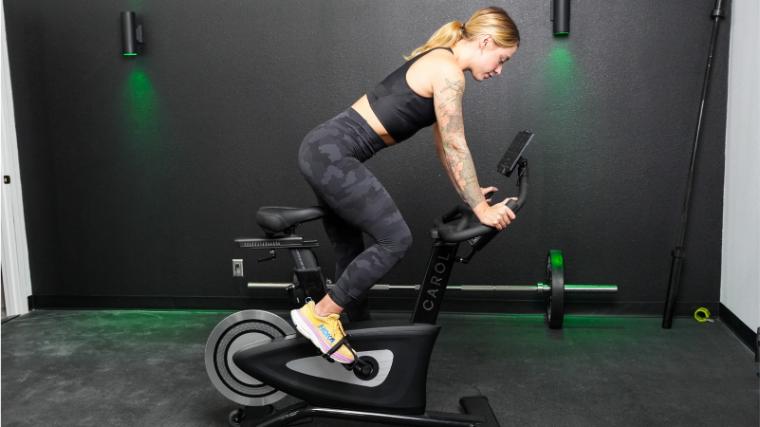You wake up on cardio day — it’s raining outside, your favorite indoor cycling class is full, and you want to hop on an exercise bike and do your own thing. Whether you’re a cyclist training for an event or a gymgoer looking for an effective workout, stationary bike workouts are highly customizable to your fitness level and goals.

Before jumping on and riding, choose your level and check out my favorite stationary bike workouts for beginners, intermediate, and advanced athletes. Each is a different type of cardio workout that you can tweak to your liking. I’ll also break down different types of exercise bikes and why you’ll want to add them to your workout program. Grab your playlist and cycling shoes.
Best Stationary Bike Workout for Your Experience Level
- Stationary Bike Workout for Beginners
- Stationary Bike Workout for Intermediate Athletes
- Stationary Bike Workout for Advanced Athletes
Stationary Bike Workout for Beginners
As a certified personal trainer (CPT), I like starting beginners with an interval workout on an exercise bike. Intervals get your body used to working at different speeds and levels of resistance. They’re not as intense as pure high-intensity interval training (HIIT), where you alternate going all out with short rest periods.
[Read More: The 8 Best Exercise Bikes for Beginners, Tried and Tested]
Intervals are also less mentally challenging than a longer steady-state ride because you keep changing your pace. Lower-intensity interval workouts help get your body and mind acclimated to cardio workouts on an exercise bike without pushing past your limits so that you can make progress from there.
RPE for Cardio Workouts
These workouts, at any level, often judge your intensity using your rate of perceived exertion (RPE) — how hard you feel like you’re working at any given moment. Here’s a breakdown of how to gauge your RPE:

- 10: Hardest effort, can‘t be sustained for more than a few seconds
- 9: Almost at your top effort, can only sustain briefly
- 8: Intense effort, can only speak a few words
- 7: Moderate effort, you can speak in short sentences
- 6: An effort where you can talk but not sing
- 5: A warm-up effort
- 4 & Below: Light effort, can be used for recovery
The Workout
Start with a complete dynamic warm-up. Make sure you adjust your bike to accommodate your body. Upright bikes are great for beginners because they resemble regular commuter bikes. Recumbent bikes are also a good option if you need or want to be closer to the floor and want or need back support.
[Read More: The Best Air Bikes for Your Home Gym]
For this workout, you’ll do five to six rounds of three-minute intervals: one minute of higher effort (not your maximum) and two minutes of lesser effort.
You can adjust your RPE on exercise bikes by playing with speed, resistance, and how hard you’re pedaling. As a beginner, keep the resistance on the lower end to get used to the fundamental movement pattern.
How Often to Do This Workout: Try this workout once or twice a week. You can do it up to two or three times.
Modifications
- Make it Easier: For many people, a recumbent bike is easier to get into and more comfortable to sit in. On an upright bike, lean forward slightly and hold on to the handlebars to support your upper body. On either bike, you can do three or four rounds to start if five or six is too much.
- Make it Harder: Play with resistance when you adjust your intervals to incorporate some strength training. As you get comfortable with the bike, choose a higher resistance for the one-minute periods, lower the resistance for the two-minute recovery periods, but maintain the same pace throughout. You can also alternate sitting and standing as you pedal.
Stationary Bike Workout for Intermediate Athletes
The endurance ride is the next type of indoor cycling workout I give my intermediate athletes. It is a common type of workout in a spin class — but this version is more straightforward so that you can do it on your own.
[Read More: Best Recumbent Bikes for Small Spaces, Streaming, Seniors, and More]
The endurance ride is a steady-state cardio workout, meaning you choose one resistance, pace, and level of effort and maintain it for the duration of your ride. It may initially feel low-intensity, but sustaining the same elevated heart rate for 30 to 60 minutes boosts your cardiovascular fitness and endurance.
The Workout
Always start with a dynamic warm-up off the bike. Then, you’ll do a quick three-minute ride at a light resistance to prepare for the bulk of the ride. Choose 30, 45, or 60 minutes for your length. Try 30 minutes on your first ride to find the correct resistance and pace for you.
How Often to Do This Workout: You can do this workout up to three times per week.
Modifications
- Make it Easier: Try this one on a recumbent bike or upright bike for 30 minutes. Go at a slower pace and with light resistance. Keep your pace and light resistance, and increase your time. Putting in less effort but increasing the duration makes it a low-intensity steady-state (LISS cardio) ride, which is still a good workout.
- Make it Harder: Do this on a spin bike to challenge your balance. While the idea is to maintain the same effort for the whole workout, you can play with adding “hills” by increasing the resistance every five minutes or so. Adding hills makes indoor cycling closer to outdoor cycling since even on a long endurance ride, you may encounter uneven terrain.
Stationary Bike Workout for Advanced Athletes
Advanced athletes will likely enjoy a HIIT exercise bike workout. One such style of HIIT is called Tabata, coined by Japanese scientist Izumi Tabata in 1996. Tabata training involves alternating 20 seconds of all-out effort with 10 seconds of complete rest for eight rounds, lasting four minutes in total.

It sounds quick, but the short rest times followed by your maximum effort catch up to you.
The Workout
After a complete dynamic warm-up, hop on and start with a short warm-up ride. You want to save most of your energy for the Tabata sequences. You’ll repeat the protocol three to four times, lasting 12 to 16 minutes. I added a short rest between each of the eight rounds.
[Read More: The Best Exercise Bikes For Heavy People]
You can do this workout on an upright, recumbent, or spin bike. For an extra challenge, try a dual-action bike, like the air bike you’ll see in CrossFit boxes. On these, you work your upper and lower body simultaneously by pushing and pulling the handlebars.
How Often to Do This Workout: Try this twice a week.
Modifications
- Make it Easier: This will likely feel easier on a recumbent or upright bike at a light resistance, harder on a spin bike, and even harder on a dual-action bike. Try the Tabata sequence just once to see how it feels in your body. If Tabata is too much, try 20 seconds on and 30 seconds off for 10 rounds.
- Make it Harder: The dual-action bike offers several options for progression; air bike workouts are tough. Four rounds of Tabata using both arms and legs make it an extremely intense full-body workout. Do one Tabata round with legs only and one with arms only, and alternate for four total (two of each).
Benefits of Stationary Bike Workouts
Wondering if you should try a stationary bike workout for your next cardio session? Here are some benefits to consider.
Customizable Cardio Workout
You can customize indoor cycling to give you the type of cardio workout you want. You can ride for a longer period at a low intensity for steady-state cardio or alternate bursts of effort with slower pedaling for an interval or HIIT workout.
Both types of cardio can help improve your cardiovascular fitness and endurance, prevent cardiovascular diseases, boost your mental health, enhance sleep quality, and strengthen your immune system. (1)
Scalable for All Fitness Levels and Fitness Goals
Since there are so many types of exercise bikes and ways to ride them, you can find the proper workout for your fitness level. Upright and recumbent bikes may be more suited for beginners — but all levels can do a more challenging workout on both types. For more of a challenge, spin and dual-action bikes (air bikes) work well for intermediate and advanced athletes.
[Read More: Benefits of Cycling to Fuel Your Next Ride]
When it comes to fitness goals, the exercise bike is also versatile.
- Fat Loss: If your goal is weight loss, you generally need to expend more energy than you take in. A stationary bike workout raises your heart rate and burns calories, boosting your total daily energy expenditure (TDEE). HIIT and steady-state workouts can also tap into your body’s fat-burning potential.
- Cardiovascular Fitness:
- Steady-state workouts on the exercise bike are great for improving endurance.
- HIIT workouts can help improve heart rate variability (HRV).
- Research suggests that Tabata training can boost your VO2 max as well as your anaerobic and aerobic capacities. (2)
- Performing HIIT on a dual-action bike after lifting can boost your work capacity and conditioning.
- Active Recovery: Taking an easy ride at a light resistance is great for an active recovery day as part of an intense workout routine.
- Recover from an Injury: Exercise bikes are popular in physical therapy offices. Depending on what type of injury you are recovering from, stationary bike workouts offer a low-impact method of staying active.
Low-Impact Workout
Low-impact workouts don’t add extra stress to your joints and soft tissues. Pedaling on an exercise bike, even at a higher resistance, lets you get your heart rate and protect your joints.
[Read More: Are Exercise Bikes Good For Weight Loss? (+ Workout From a Personal Trainer)]
While a low-impact ride is great for injury recovery, non-injured athletes may also prefer it. You can get a great HIIT workout without adding extra stress to your hips, knees, and ankles compared to a treadmill workout where you alternate sprints and jogs.
Works Lower Body
Professional cyclists tend to have strong legs. While cycling alone may not be enough to build muscle unless you do an extremely high volume, riding an exercise bike still works and may somewhat strengthen your lower body.

Pushing and pulling the pedals with resistance works your glutes, hamstrings, calves, and especially your quads. Some spin classes may also incorporate light dumbbells for upper body work.
Convenient for Home Workouts
Exercise bikes are a popular option for working out at home. They don’t take up much space, and you can opt for a budget exercise bike if you can’t spring for a Peloton. Having a stationary bike at home may make you more likely to hop on for a quick workout on a busy day.
Types of Stationary Bikes
Here’s a quick breakdown of the types of stationary bikes you’ll encounter in gyms and cycling studios.
Upright Bike
The upright bike looks similar to a regular bike. The seat is above the pedals, and the handlebars are in front of your body. For best results, you can adjust the seat to about hip height. Upright bikes often have a screen that allows you to adjust your resistance and track your time, speed, and pedal strokes.
Recumbent Bike
The recumbent bike is low to the ground. It has a wide seat and backrest with handlebars on either side, so you hold your arms by your sides. The pedals are in front of you, allowing you to recline while you ride. There is also often a screen to track your variables.
Spin Bike
You’ll find a spin bike in gyms and indoor cycling classes like SoulCycle. The popular Peloton bike is a spin bike. They are meant to mimic road bikes for races. Spin bikes have a heavy flywheel with the pedals attached to it. You have to lean all the way forward to reach the handlebars, but you can also sit up tall or alternate.
[Read More: The Best Exercise Bikes for Small Spaces, Expert-Tested and Reviewed]
Spin bikes often have screens where you can choose your own workout, track your variables, or follow a video spin class.
Dual-Action Bike
A dual-action bike provides an optional full-body workout. You push and pull the handlebars with your arms (similar to an elliptical) while you pedal. You sit upright with the pedals below the seat and lean forward slightly to reach the handles.
An air bike is a type of dual-action bike popular in CrossFit. Its fan uses air to create resistance. The harder you pedal, push, and pull, the more challenging it will be.
Frequently Asked Questions
Here are the most burning questions I get about stationary bike workouts (and their answers, of course).
How long should you work out on a stationary bike?
A HIIT workout on a stationary bike can take five to fifteen minutes. A steady-state workout should last 20 to 60 minutes or more.
Can you lose belly fat by riding a stationary bike?
You can’t effectively target fat loss in your body. To burn fat, you generally have to reduce your calorie intake. Boosting your energy expenditure by riding a stationary bike can also help, but you can’t really control where you lose fat.
Is 30 minutes of the exercise bike a day enough?
Yes, riding the exercise bike for 30 minutes daily is enough to boost your cardiovascular health and fitness. However, it’s helpful to be specific in your goals. For example, you’ll probably want to do more if you’re training for a race.
References
- Nystoriak MA, Bhatnagar A. Cardiovascular Effects and Benefits of Exercise. Front Cardiovasc Med. 2018 Sep 28;5:135.
- Emberts T, Porcari J, Dobers-Tein S, Steffen J, Foster C. Exercise intensity and energy expenditure of a tabata workout. J Sports Sci Med. 2013 Sep 1;12(3):612-3.
The post The Best Stationary Bike Workout for Your Experience Level, According to a Personal Trainer appeared first on BarBend.

